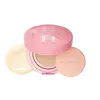Cher Skincare BB Water Resistance Physical Sunscreen SPF 50 Versus Her Hyness Nude Air Anti-Acne Serum Cushion SPF 50+
What's inside
What's inside
 Key Ingredients
Key Ingredients

 Benefits
Benefits

 Concerns
Concerns

No concerns
 Ingredients Side-by-side
Ingredients Side-by-side

Cyclopentasiloxane
EmollientDimethicone Crosspolymer
Emulsion StabilisingDimethicone
EmollientTitanium Dioxide
Cosmetic ColorantZinc Oxide
Cosmetic ColorantGlycerin
HumectantSaccharum Officinarum Extract
MoisturisingSodium Polyacrylate
AbsorbentPolyisobutene
Polymethylsilsesquioxane
1,2-Hexanediol
Skin ConditioningMethylpropanediol
SolventEthylhexylglycerin
Skin ConditioningHydroxyacetophenone
AntioxidantCI 77492
Cosmetic ColorantCI 77491
Cosmetic ColorantCI 77499
Cosmetic ColorantWater
Skin ConditioningDiisopropyl Adipate
EmollientIsononyl Isononanoate
EmollientIsoamyl P-Methoxycinnamate
UV AbsorberTriethylhexanoin
MaskingSilica
AbrasivePolyglyceryl-2 Dipolyhydroxystearate
Skin ConditioningGlycerin
HumectantPentylene Glycol
Skin ConditioningPEG-30 Dipolyhydroxystearate
EmulsifyingPersea Gratissima Oil
Skin ConditioningDisteardimonium Hectorite
StabilisingMagnesium Sulfate
Phenoxyethanol
PreservativeTribehenin
EmollientBoron Nitride
AbsorbentMica
Cosmetic ColorantCetearyl Alcohol
EmollientCetearyl Glucoside
EmulsifyingAluminum Hydroxide
EmollientChlorphenesin
AntimicrobialAluminum Dimyristate
Emulsion StabilisingAlumina
AbrasiveStearic Acid
CleansingLauroyl Lysine
Skin ConditioningHydrolyzed Corn Starch Octenylsuccinate
AbsorbentButylene Glycol
HumectantPropanediol
SolventXylitol
HumectantCaprylic Acid
CleansingAscorbic Acid
AntioxidantHydrated Silica
AbrasiveTocopherol
AntioxidantRoyal Jelly Extract
Skin ConditioningCI 77891
Cosmetic ColorantCI 77491
Cosmetic ColorantCI 77492
Cosmetic ColorantCI 77499
Cosmetic ColorantWater, Diisopropyl Adipate, Isononyl Isononanoate, Isoamyl P-Methoxycinnamate, Triethylhexanoin, Silica, Polyglyceryl-2 Dipolyhydroxystearate, Glycerin, Pentylene Glycol, PEG-30 Dipolyhydroxystearate, Persea Gratissima Oil, Disteardimonium Hectorite, Magnesium Sulfate, Phenoxyethanol, Tribehenin, Boron Nitride, Mica, Cetearyl Alcohol, Cetearyl Glucoside, Aluminum Hydroxide, Chlorphenesin, Aluminum Dimyristate, Alumina, Stearic Acid, Lauroyl Lysine, Hydrolyzed Corn Starch Octenylsuccinate, Butylene Glycol, Propanediol, Xylitol, Caprylic Acid, Ascorbic Acid, Hydrated Silica, Tocopherol, Royal Jelly Extract, CI 77891, CI 77491, CI 77492, CI 77499
Ingredients Explained
These ingredients are found in both products.
Ingredients higher up in an ingredient list are typically present in a larger amount.
Ci 77491 is also hydrated iron III oxide. It's sole purpose is to give a red/pink hue to products.
Iron III oxides are classified as inorganic chemicals for coloring.
Synthetically created Ci 77491 is considered safer than those naturally found. This is because the synthetically created version may contain less impurities. Iron oxides are generally non-toxic and non-allergenic.
Learn more about CI 77491Ci 77492 is also hydrated iron III oxide. It's sole purpose is to give a yellow hue to products.
Iron III oxides are classified as inorganic chemicals for coloring.
Synthetically created Ci 77492 is considered safer than those naturally found. This is because the synthetically created version may contain less impurities. Iron oxides are generally non-toxic and non-allergenic.
Learn more about CI 77492Ci 77499 is also hydrated iron III oxide. It is created from mixing red and black iron oxides. This helps give shades of darkness to a product.
Iron III oxides are classified as inorganic chemicals for coloring.
Glycerin is already naturally found in your skin. It helps moisturize and protect your skin.
A study from 2016 found glycerin to be more effective as a humectant than AHAs and hyaluronic acid.
As a humectant, it helps the skin stay hydrated by pulling moisture to your skin. The low molecular weight of glycerin allows it to pull moisture into the deeper layers of your skin.
Hydrated skin improves your skin barrier; Your skin barrier helps protect against irritants and bacteria.
Glycerin has also been found to have antimicrobial and antiviral properties. Due to these properties, glycerin is often used in wound and burn treatments.
In cosmetics, glycerin is usually derived from plants such as soybean or palm. However, it can also be sourced from animals, such as tallow or animal fat.
This ingredient is organic, colorless, odorless, and non-toxic.
Glycerin is the name for this ingredient in American English. British English uses Glycerol/Glycerine.
Learn more about Glycerin